


|
Joined:
|
28/01/2011 |
|---|---|
|
Last Updated:
|
28/01/2011 |
|
Location:
|
Gjøvik, Norway |
|
Climate Zone:
|
Cold Temperate |
|
Gender:
|
Male |
|
Web site:
|
permaliv.blogspot.com/ |
(projects i'm involved in)
(projects i'm following)
Back to Øyvind Holmstad's profile
Posted by Øyvind Holmstad over 14 years ago
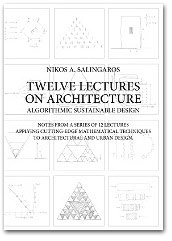 The goal of permaculture is to reunite man with nature and man with man through design systems, and here patterns play an important role. Still, patterns can only reunite humans with natural systems and with each other, not with the geometry of the universe. Surely in what I like to call permatecture, better known as biophilic architecture, biotecture or neurotecture, patterns are crucial. But for the creation of wholeness and life we need a whole range of tools.
The goal of permaculture is to reunite man with nature and man with man through design systems, and here patterns play an important role. Still, patterns can only reunite humans with natural systems and with each other, not with the geometry of the universe. Surely in what I like to call permatecture, better known as biophilic architecture, biotecture or neurotecture, patterns are crucial. But for the creation of wholeness and life we need a whole range of tools.
When “A Pattern Language” was first published in 1977, architects immediately assumed that it was a design manual, and used it to generate some very interesting buildings. Those buildings, despite their positive human qualities, lack an overall coherence, and people did not understand why this was happening. The reason is that the Patterns provide essential and necessary constraints, and not a design method in itself. The actual design algorithm was developed by Alexander, but only many years later. – Twelve Lectures on Architecture, by Nikos A. Salingaros, page 106
The new book by Professor Nikos A. Salingaros, Twelve Lectures on Architecture; Algorithmic Sustainable Design, is like a Swiss Army Knife of tools for creating ultimate human habitats, or EEAs. Nobody cares about something they don’t love, and nobody loves anything that contradicts nature, because the human biophilia is nature!

Still, what Nikos has done is more like the work of an archaeologist, rediscovering old tools from the past, serving humanity through millennia. And he explains how to use these tools to rediscover the old form languages of our world, or even to create new form languages carrying the truth and poetry found in the form languages of all times. What do these thousands of form languages from throughout human history have in common? The answer is that they reflect the innate geometry of nature and that they don’t contradict the laws of physics.
This was the goal of human architecture, to become one with nature, to make our world whole! Until Le Corbusier and the realm of Modernism, when the nature of order got broken!
The Nature of Order as a "Pocket Book"
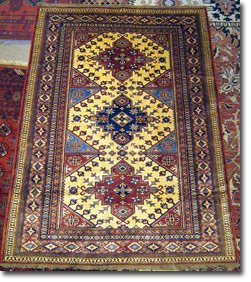 Afghan carpet |
For those reading the groundbreaking Nature of Order — books by Christopher Alexander (I must admit I’ve not finished this series yet) — it must seem impossible that they can be compressed to a pocket book. And of course this is impossible, and Nikos’ book is somewhat larger than a pocket book too. Still, in a way it’s true. Twelve Lectures on Architecture is in many ways a compression of this work by Alexander. And this is both impressive and important — important for all those put off by the size and the long philosophical discussions of the Nature of Order books. For example, Alexander’s 15 properties of life cover a whole book in his work, while Nikos has “reduced” them to ten lofty pages. Here it’s just to grab the very essence and start using every tool immediately, creating new and life-generating design!
Human beings, with their evolved physiology and perception mechanisms, are the most perfectly-tuned instruments for detecting the presence or absence of the 15 properties. At this time, however, architecture critics and architectural academics value forms that violate the 15 properties. The paradigmatic “good” architecture in a contemporary style clashes with the 15 properties, they are immediately perceived as contradicting the dominant architectural aesthetic, and are dismissed as irrelevant to design. The fact that they are supported by massive scientific research does not convince architects. Persons trained to value a certain “look” cannot be forced to admit that the dominant style generates psychological and physiological anxiety. Our genuinely good examples are judged because they provide emotional nourishment, which is found primarily in traditional construction and artifacts. – Twelve Lectures on Architecture, by Nikos A. Salingaros, page 124
I’ll recommend everybody who plans to read Alexander’s The Nature of Order to first read Nikos’ Twelve Lectures on Architecture. A better introduction you can’t get!
Anti-Gravity Anxiety
A tree is anti-anti-gravity anxiety! And the older a tree, or a forest, the more relaxed we feel sitting beneath it, or walking through it. This is because this force grows in strength together with the tree, as the roots, the stem and the crown widens. Just like with a column, with a base, a stem and the crown. Throughout history mankind always obeyed the law of a tree, until the modernists got the idea of breaking this law making pillars with no base or crown — some even sharpened on the top like a pencil, in every way contradicting the powers of gravity visually. Unfortunately this is just one of many examples of anti-gravity anxiety found in modernism. In fact, it has become the world standard!

Anti-anti-gravity anxiety in action.
Photo: Evelyn Simak
There is something profoundly disturbing about buildings that consist of horizontal slabs. We can understand this physiological/psychological reaction because of anti-gravity anxiety. A large number of horizontal buildings have been built around the world, their architects ignoring our negative reaction to them. In addition to affecting our senses, this method kills architectural design in three dimensions, since building facades cannot be created within this narrow design paradigm. – Twelve Lectures on Architecture, by Nikos A. Salingaros, page 52
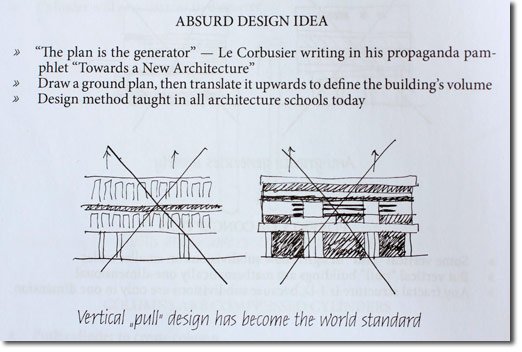
Fractals and Symmetries
Is there more to learn from a tree? Yes, among its fruits are fractals and symmetries, needed to create sustainability and stability. Fractals are patterns or parts repeated on every scale, from the largest to the smallest, where the largest fractals dominate in size and the smallest in numbers. Fromthe tree as a whole to the smallest leaf and the smallest part of a leaf we find a repeating structure and symmetry.
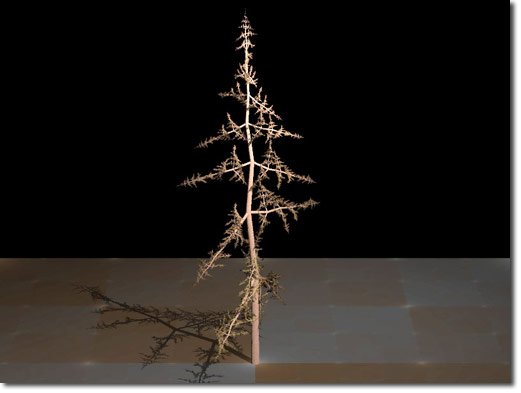
Every sustainable system consists of a fractal structure. In a tree these fractals are made up by visual patterns, while in a system design they consist of pattern languages. This is why in an agricultural pattern language the smallest farms should be more prevalent than larger farms, and again vegetable gardens (pattern 177) to be more prevalent than small farms. The same thing goes for an economical pattern language and so on. This way a fractal society creates life on every scale, where people can thrive and not feel lost (the human scale), like so many do today.
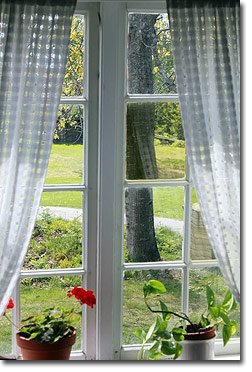 A fractal view (pattern 238 & 239) |
Modernism, on the contrary, is anti-fractalism! (No wonder why corporations have embraced their ideology.) For windows, for example, they claim that large panes lacking fractal properties help to bring nature into your house. The opposite is true! A fractal structure is strengthening the view, whether it consists of small panes or plants filling up your window. Alexander discovered this truth a long time ago!
Universal Scaling
Nikos A. Salingaros has studied a lot of buildings from all continents and times, and his conclusion is that there exists universal scaling or fractal hierarchy.
I’m giving out a challenge by claiming that the vast majority of buildings all around the world before the industrial age obey universal scaling (and actually continuing into early industrial years). This holds for all different cultures, all different periods, and is not restricted to a few carefully-selected buildings that I might refer to here. This claim can be documented by on-site measurements, and then the term “universal” becomes apparent, since it applies to indigenous architectures, both vernacular and monumental. Universal scaling is therefore innate to how human beings create forms, and is not a feature tied to any culture. – Twelve Lectures on Architecture, by Nikos A. Salingaros, page 25-26
To apply universal scaling to what we make Nikos has given us several tools, some very accurate but which take more time, and some more approximate but faster. They all come out with about 2,618, and are so related to the golden mean. Scaling coherence is essential, because all natural environments obey this law, and if we contradict it we contradict ourselves. It’s essential to pay extra attention to the human scale, ranging from two meters down to two millimeters. One of the many tragedies of modernists is that they are completely neglecting the human scale, regarding it as “clutter”. And even worse, their hero Le Corbusier even thought of children as “clutter”!
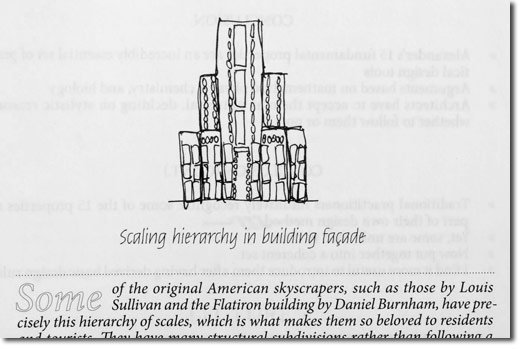
Generative Codes are a Kind of Algorithm
The creation of complexity has to go stepwise, this is a fundamental law!
And the fundamental answer is, that there is a fundamental law about the creation of complexity, which is visible and obvious to everyone – yet this law is, to all intents and purposes, ignored in 99% of the daily fabrication process of society. The law states simply this: ALL the well-ordered complex systems we know in the world, all those anyway that we review as highly successful, are GENERATED structures, NOT fabricated structures. – The Process of Creating Life, by Christopher Alexander, page 180
Generative codes follow this law, like the DNA in the creation of an embryo, following an encoded instruction for each step. Or like an algorithm following certain rules going stepwise. But unlike for a mathematical algorithm the end result is not set; the code helps us to reach one out of several desired end results, while avoiding undesirable end results.
Codes used to create life:

Life is not a blueprint but an algorithm
The need for adaptive algorithms:
The goal is always identifying and strengthening centers, where the many smaller centers focus upon the larger centers (like for a tree) to make a coherent, living whole!
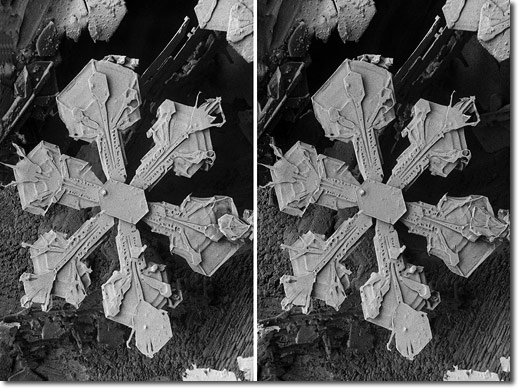
Centers strengthens centers to make strong centers and a coherent
living whole, here seen in snow crystals
The theory of centers:

Another strong center, Hamandir Sahib or Darbar Sahib (also known as the Golden Temple). The holiest shrine in Sikhism located in
the city of Amritsar, India. Photo: Oleg Yunakov
The Form Language
A pattern language is system design or interactions, while a form language is what makes the pattern language beautiful. A pattern language has to be the basis of any neighborhood, while the form language is what brings the pattern language alive and makes the place distinct. Only when you mesh the form language with your pattern language your design is complete, or a living whole.
Patterns are universal while form languages are local, still all reflecting the innate geometry of nature, which is so complex that millions of form languages can be created. Another name of Nikos’ book could have been A Form Language, and when you have A Form Language and A Pattern Language, you have the power in your hands to create the ultimate living design.
In old times the form languages changed from one valley to another, from one town to another, giving each place its innate poetry. While modernism (the International Lie) has in its arrogance rejected the very existence of a form language, this is why modernistic typologies look the same the world over. Making a global monoculture of architecture!
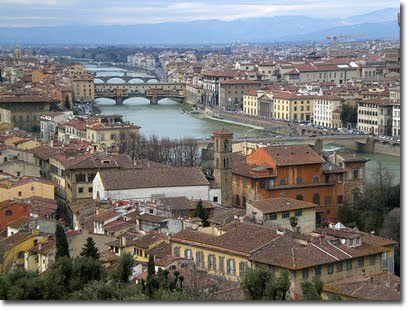
Poetry written in stone! Florence, Italy
With one stroke, we have hopefully laid to rest the common terror that traditional form languages restrict architectural creativity. This statement is mathematically false. We can use an adaptive design algorithm with a traditional form language to design different buildings depending upon different initial conditions. Classical and traditional architects know that. By adapting to local conditions, buildings and cities become unique while using the same algorithm. And there exist many distinct adaptive design algorithms that have evolved over the millennia of human existence. Using these algorithms with different local conditions makes possible an infinity of innovative results. – Twelve Lectures on Architecture, by Nikos A. Salingaros, page 85
A Better Focus
There are so many tools I should like to introduce for you from Nikos book, but as I don’t know how to draw I would have to copy the whole book for its illustrations. This is one of the strengths of the book, the many illustrations. I’m in no way an expert on how to use the tools of this book, and to become a master you need many years of practice. Using them was for generations a natural part of people’s cultural genetic code. We should be very grateful to Nikos for picking up the broken pieces, restoring them and giving them back to us. Sadly too many can’t admit that what we did over the last 100 years is fundamentally flawed, giving them cognitive dissonance.
This book by Nikos gives you a better perception of the world, both for what is ugly and what is beautiful. And while it can even break your heart when you realize the ugliness that modernism has created within it, you are more than compensated by gaining a new appreciation and acceptation of the innate beauty of our world.
When I wrote my article “Modernism & Disconnection from Life” I didn’t know really why I loved so much more being on a glacier than on the Norwegian Opera image of a glacier. There are of course many reasons, but one important is that Engabreen, a glacier arm of Svartisen, consists of a strong horizontal compression, just like the fluting on a column.
Two examples of horizontal compression:
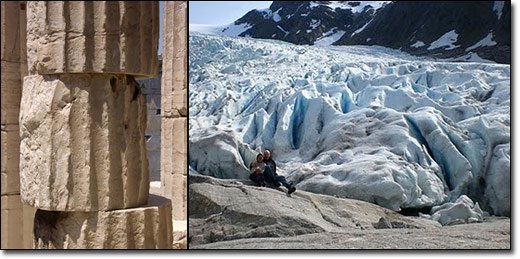 |
| Left photo: Guillaume Piolle |
Compression is a force that correlates to human biophilia. The image of a glacier lacked this force. But it also lacked another fundamental part of biophilia, the fractal dimension.
Space is perceived according to its fractal dimension, as established by the British architect Andrew Crompton (Environment & Planning B 28, 2001, pages 243-254). I believe this to be a property of our perceptual system that applies to all animals. We seek the protection of a fractal environment that has scales corresponding to our body and its parts and avoid non-fractal open spaces. Survival originally depended upon being able to physically fit into the environment. Whenever possible, children create fractal play environments using furniture and toys: for example, cubbies, dollhouses, and secret spaces in which they and their toys fit. By adding smaller components to the existing adult space (or by subdividing it), they experience a LARGER spatial complexity. On the urban scale, historic city centers with fractal structure are experienced as LARGE, whereas in fact they are dwarfed by contemporary non-fractal urban spaces that no one wishes to use. – Twelve Lectures on Architecture, by Nikos A. Salingaros, page 65
Toward a New Permatecture Future
By now the permaculture movement has focused upon patterns (pattern languages), and that’s good, but now it’s time to focus more upon forms (form languages). With this new toolbox from Nikos we have the tools needed to truly reunite man with nature both through innate biophilic patterns and geometry.To respect and care for nature we have to create nature through infusing all we create with the geometry found in nature, and to obey the laws of nature. A reason why so many don’t care about nature today is that our cities and towns are anti-nature. Modernism and modernistic ideology is pure hatred against nature!

Sunrise, Manaslu, Nepal, Himalaya. Photo: Ben Tubby
The machine aesthetic:
If we don’t understand how to build nature into everything we create, then our pocket neighborhoods, ecovillages, village towns and transition towns will be both inhuman and anti-nature. For the future I hope these tools well be a part of every Permaculture Design Course!
I’d love to see a future with a permatecture institute in every city! The International Society of Bio-urbanism, where Professor Nikos A. Salingaros is a member of the Scientific Committee, is already highly influential in Italy. I’m sure they’ll help us to get started.
Twelve Lectures on Architecture can be used as a template for, just as the title says, twelve lectures of architecture. It could be held through a weekend. But it can easily be extended to a twelve week course to get in-depth training for using all the tools of the book.
We are now given the tools needed to reunite the man-made world with the natural world, so let’s start the work!
Watch the original lectures from which the book has evolved:
Buy the book:
Join the Salingaros Group:
Further reading:
Original article available here.
This article is published at The Permaculture Research Institute of Australia on June 19, 2011. Excerpted at the P2P Foundation on June 25, 2011. Published at Energy Bulletin, USA, on June 27, 2011.
You must be logged in to comment.

| Permaculture Design Course |
| Type: Permaculture Design Certificate (PDC) course |
| Teacher: Aranya Austin |
| Location: Orreviks Gård, Sweden |
| Date: Jul 2011 |